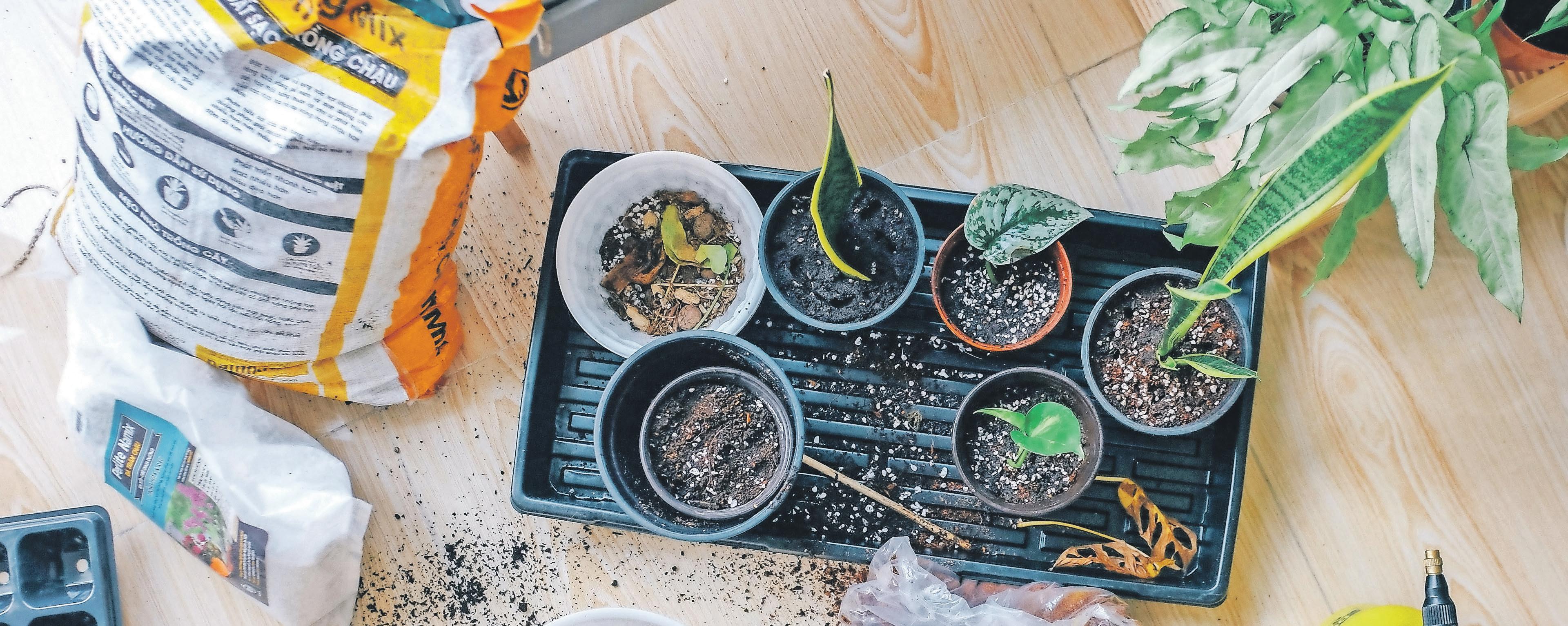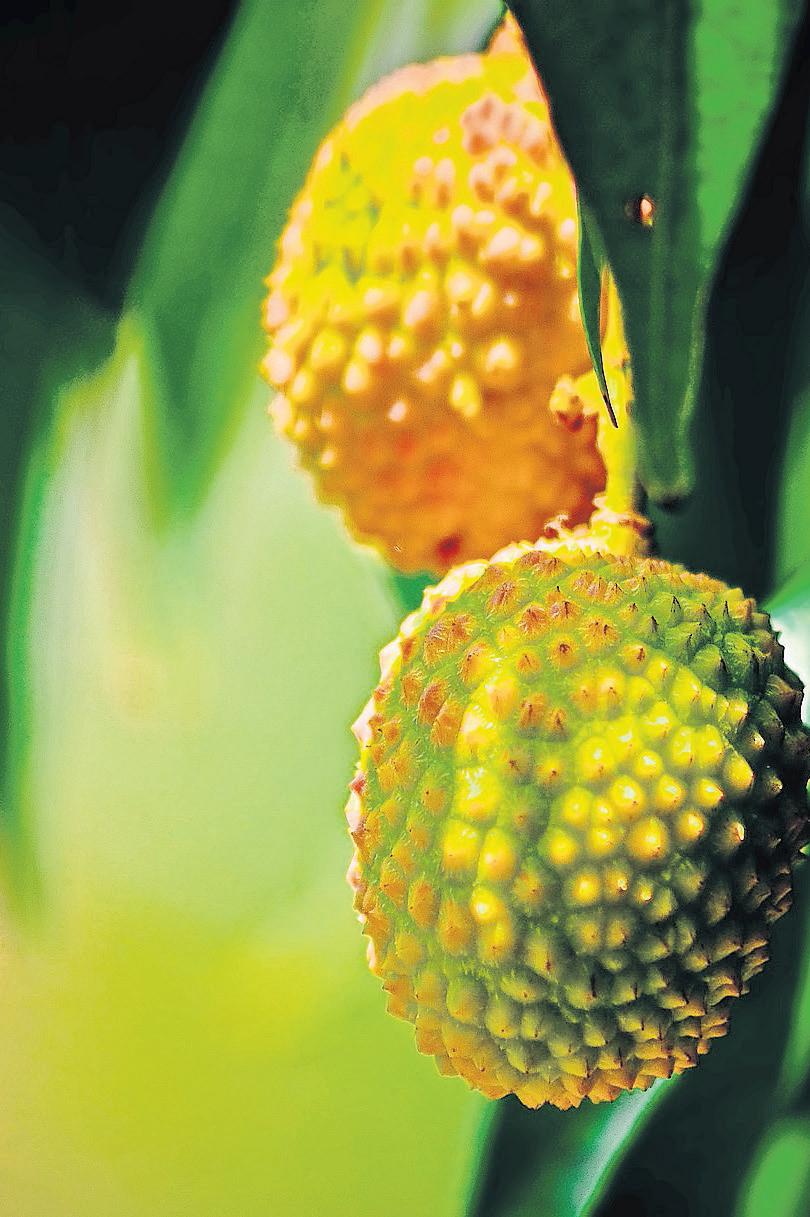
7 minute read
Gardening
from 08132021 WEEKEND
by tribune242
gardening Repotting 101
16 | The Tribune | WeekendFriday, August 7, 2020
Advertisement
gardening gardening
W3WEEKEND W16WEEKEND
Friday, July 23, 2021The Tribune | Weekend | 11
All about the Pruning for lychee tree tree strength
THE hot weather has many of us retreating from the garden into cooler spaces or indoors.
I’m watching garden weeds go ballistic, and I am not too worried about it because we will get to them eventually. For now, they’re for the butterflies and the pollinators. It may be a good time to look at repotting some indoor plants if you have any in your office or house, or patio plants that may have been in the pot for a long time that may have become rootbound (more roots than soil).
There are two ways that repotting can be done; one is to take the plant out of the pot it is in to pot it up into a larger pot size. Often for indoor plants this is not so feasible though, maybe because of the decorative pot size, space available in a particular location, or because potting up may simply make the plant too large and cumbersome to manage indoors.
The second method is to take the plant out of the pot it is in, trim some roots and pot back into the same original size.
Let’s look at the first method: Potting soil can become exhausted, compacted, waterlogged, or extremely dry, or the plant may have become rootbound, and need some help to get more space to grow. Remediation can be difficult if the roots are in poor health, or it is extremely rootbound, the most efficient thing is to take the plant out of the pot, gently remove the old soil from around the roots by hose or by hand, remembering that the roots have very fine parts that can tear or break easily. These feeder roots are delicate, but because we do not have to deal with cold weather, it really won’t affect things too much if you’re a bit rough on the roots, things don’t really stop growing here. Loosening the roots can also help. Prepare the new, larger pot with a base of a specific potting media, set the plant into the new pot, and back fill it with a new potting mix being mindful to not fill the soil higher than the original soil line.
Many plants do not want their stems buried in soil. Water the plant into the new media. I always like to apply a tablespoon or three of a slowrelease fertilizer to help the transition and to give the plant a boost of nutrients to encourage stronger and faster growth into the new pot. Just a note, Black Kow, manure, compost and the likes do not make for good potting medias as they often do not have enough airspace, drainage, or moisture holding capacity and they are easily compacted and may contain pests or weed seed. It is generally recommended to use potting medias designed for interior or exterior potting, depending upon your situation.
The second method of trimming roots comes in handy when the plant is in a high-end decorative pot, or if it is desired to be kept in a spot with limited space. The simplest thing to do is to take the plant out of its pot and slice off the bottom third of the root system with a sharp knife, clippers, machete, or scissors. This can be quick and easy and many of the tropical plants that are used as interior plants are very tolerant of this method. Simple as that, slice off the
GOOD day, gardeners! Time flies, bottom 30 percent or so of the root, yes? Time is subjective also. Had I remove the old potting soil from the planted a lychee (Litchi chinensis pot and around the roots, and then Sonn/Nephelium litchi Cambess) set a fresh base of a new potting soil from seed 15 or 20 years ago, I might have a few lychee fruit from that tree by now to enjoy. Until then, they are a demanding shade tree at best. Not particularly fast growing, the lychee takes its time to mature, and this is the reason that air layering exists. Commercially, they are layered for propagation as they grow a strong enough rootstock by that back into the pot, set the plant in so that the original soil line is towards the top of the pot, and back fill with fresh potting media. Water it in and apply some nutrients and move it back to its original location! Bam, all done. Usually, a repotting of indoor plants can last for two to three years, unless it is really happy, then it may method and remain true to type. It is be necessary to give it an annual root said that the choicest varieties have pruning. Typically though, this only greater variation in offspring quality, has to be done every second or third and that the seed of the lychee is only year for most of the material that is viable for four to five days, so it is not used indoors. It always benefits to something that is recommended to add a layer of mulch to help preserve buy from unknown sources over the moisture and add organic material internet. I do not have 15 or 20 years to the pot as the mulch breaks down to wait on those fruit, if you have got over time. Bringing the outdoors to kids, well, eventually they may thank the office or home is aesthetically you for planting some of them. It certainly does not hurt to plant them anyway; every tree benefits every one of us. If you are seeking lychee fruit in a faster time frame though, and if you have space for only a tree or two espepleasing and somewhat therapeutic, as well as giving the added benefit of removing toxins from the air and producing oxygen in return. So, beat the heat and bring garden indoors! As always, I wish you happy gardening. cially, do not even bother with seeding them. Layer from a friend or neighbour’s tree or buy from a reputable supplier. Now, don’t get upset with me if you’ve just seeded some and you’ve got the space to plant them and let them grow, grow them!
Lychee trees are not very salt tol base where they can thrive. At the Redlands in South Florida there are lychee groves that are highly productive in the good years (they are apparently quite cyclical), and when I was roaming the area a few weeks ago the trees were loaded, but the fruiting season in that location is finished now. The current issue now for lychee in the region (other than too much
NOW that we have had the first storm of the season pass through, pruning is again on my to-do list in the garden. We had some small trees get blown down in that (fortunately) weak tropical system Isaias, and it reminds me that tree pruning needs to continue. It is also a great time to prune hedges, shrubs, perennials, and anything branching. Much of the garden should be growing quite quickly at this time of year. If your garden is not growing quickly it may be worth doing some fertilizing to green and boost branching, flowering and root development. For those of us that are relegated to our own property to help stem the spread of COVID-19, get your clippers, hedge shears, saws or scissors out and get trimming!
It’s important to do a few things correctly when it comes to pruning larger trees, and even medium and small trees will benefit from these steps. Primarily, it is all about the branching angles. Wider angles make for stronger branching. Tighter angles make for weak branching. Early corrective pruning when the tree is young is the efficient way to location away from wind and salt prevent much heavier work in the spray. Choose an area with deep soils future. Try to encourage the crotch if possible and give them ample supangles on branches to be at least plemental nutrients throughout the

heal properly without allowing for pests or disease to intrude. Here are some helpful pointers for pruning: • Dead, dying or unsightly twigs and branches. • Sprouts growing near the base of the trunk. • Crossed branches and branches growing toward the centre of the tree. • Narrow crotches. If it is possible
By ADAM BOORMAN • Tribune Features Reporter • acadet@tribunemedia.net
establishment. If there are no native trees in your yard, please consider planting one or more, if you have the space. If you do not have space for

Adam Boorman
An example of a weak branch angle susceptible to splitting. This type of branch should be removed.
SLOW to grow and a demanding tree, you will have earned the fruits of your success if you cultivate lychee.
• Adam Boorman is the nursery manager at the Fox Hill Nursery. You can contact him with any questions you may have, or topics you would like to see discussed, at gardening242@gmail.com.






